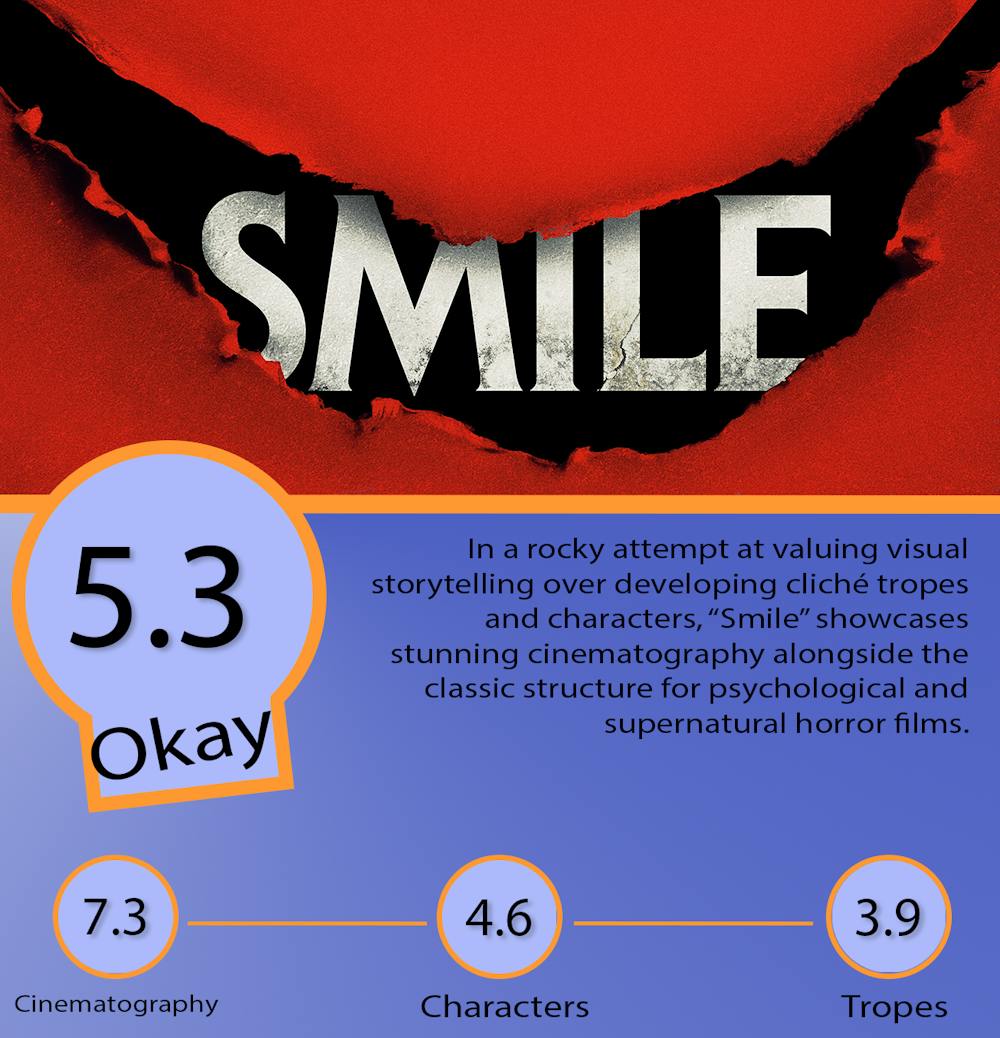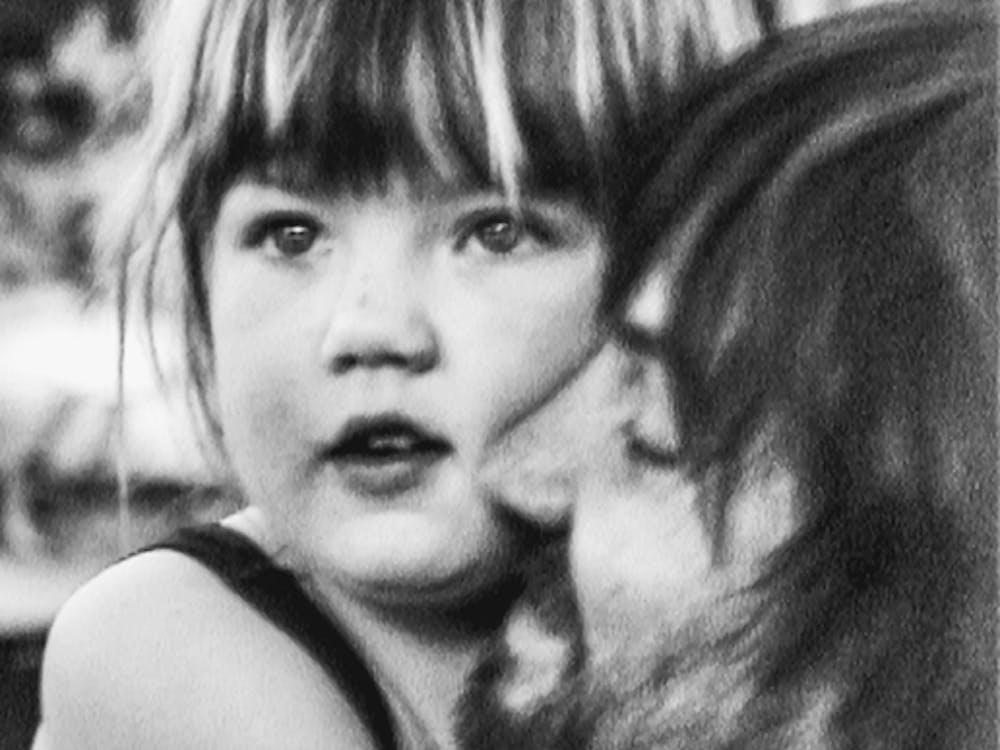Directed and written by Patrick Finn, Smile expands upon a world originally explored in his own short film Laura Hasn’t Slept from 2020. Dr. Rose Cotter (Sosie Bacon), a therapist at a psychiatric emergency room, begins experiencing strange, frightening occurrences after witnessing the gruesome death of a patient. Not only does she confront her own past traumas, but she seeks to unravel the mystery of why such a creepy smile is following her. The disease is reminiscent of that found in the 2014 film It Follows, though instead of spreading sexually, Smile creates a linking of PTSD. Those who witness the suicide of the evil spirit compelling them to commit the act are then themselves the next victim, as is clearly seen with Rose’s patient and with Rose.
Camera work served with a smile
The storyline is simple, and certainly not new to the horror genre. It is Finn’s dedication to the cinematography that elevates the movie from tired tropes to something worth watching. It’s clear that this is a story he’s passionate about capturing. Likely because of the ability to finally showcase the entire world he’s been building, rather than just a slice as he had to for his short film. Finn tells his story as any good director would: with breathtaking visuals. He shoots Rose differently as the plot progresses. From the beginning we are forced to stare her in the face, an apt choice for a film that relies so heavily on analyzing someone’s features. As time goes on the shots become wider, soaked in harsher light. Rose has less makeup on and far more of the natural effects of her lack of sleep shine through. Finn’s choice in how he captures her exaggerate the agitation in her features, an advantage that helps drag the audience into the story. It feels as though the bags under our eyes are as heavy as Rose’s appear to be, unsettling to feel as it is to look at. Granted, some of the more remarkable shots recall other films within the genre. Throughout the movie, Finn relies heavily on upside down shots, making the audience feel as though they cannot get a grip on reality just as Rose cannot. However, it feels eerily similar to a far superior Midsommar. That doesn’t take anything away from the talent of Finn as a director. He’s good at what he does, but there are times where the movie feels more like a focus on what he can do as a director over what it takes to create a compelling story.
Characters not worth a grin
Most characters with the movie feel vastly one-dimensional, whether that be the ex-boyfriend cop (Kyle Gallner), well-meaning fiancé (Jessie T. Usher), or gentle-toned and utterly dismissive therapist (Robin Weigert), there isn’t much of a depth to what they have to bring to the film. None of them seem extremely present either. Joel, the ex, takes far too long to link the suicide chain to something made obvious within the first 10 minutes of the film. It seems that the only character the movie felt worth developing is Rose. Sosie Bacon, daughter of Kevin Bacon and Kyra Sedgwick truly committed to her performance. The screams and cries for help to elevate the sheer dread of seeing an overexaggerated, devious smile plaster across a character we watched die before our eyes. Of course, Bacon is no stranger to playing characters heavily rooted in trauma. Her character, Skye, in Netflix’s Thirteen Reason’s Why also explored rocky mental health. It’s promising to see her growth from the series to this movie. In Smile, Bacon’s performance is truly compelling. Pair that with some disconcerting visuals of smiles and there’s enough to leave you squirming in your seat.
A film with a tired expression
As expected of the horror genre, viewers are often a few steps ahead of the characters. In Smile, it isn’t hard to connect the dots of where the story is headed except, perhaps, for the very end. Those startled by the main antagonist, the personification of trauma, may find it to be trippy. Then there’s the less than subtle metaphors—a bright smile hiding the pain and suffering beneath. Quick, visual jump scares are surprisingly effective throughout the film. Hidden behind a toothy, slightly unsettling grin, it takes a while for the viewer to realize that the film is merely relying on tired horror tropes instead of delivering anything new to the genre. Like the overused Lewton Bus, a scene that slowly builds tension and then gives the viewer an unexpected jolt with something that turns out to be completely harmless, the director seems to lean on. There are more moments of frustration toward the breaking tension than properly allowing it to marinate and stalk the audience as the film progresses. It’s a pity to see the lack of work to create something psychological out of something that seemingly prides itself in its awareness of mental health.
Just another toothless horror film
Produced by Paramount Players with an hour and 55-minute run-time, Smile holds a lot of room for the audience to become bored of these tired tropes. Watching it in theaters certainly adds to the experience. Loud, jolting noises accompany jump scares that will send popcorn flying out of the box, but an at-home viewing will leave more room to realize that the plot is rather lacking. At times it feels as though the audience is an entire act ahead of the characters, rather than a few steps as horror genres often rely on. The only saving grace is Finn’s commitment to his craft and the full-dimensional character Bacon portrays. It's entertaining in its own right and will certainly make a name for itself within the genre.

Sources
IMDb, IMDb, IMDb, IMDb, IMDb, IMDb, IMDb, IMDb, IMDb, IMDb, IMDb, IMDb
Photos


















